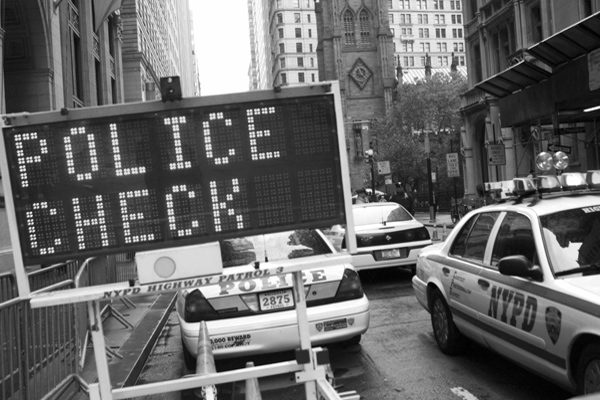Bronx
How Free? Liberties In Post-9/11 New York
Karen Loew |
Around the five boroughs, New Yorkers are divided over the freedom they have, what they are willing to give up and what they already may have lost.

An NYPD checkpoint on Broadway near the financial district.
Around the five boroughs, New Yorkers are divided over the freedom they have, what they are willing to give up and what they already may have lost.
A 1998 New York Civil Liberties Union survey identified 2,397 surveillance cameras at street level in Manhattan. In 2005, another NYCLU survey of Lower Manhattan, Greenwich Village, Chinatown and central Harlem found 4,468 cameras in those four districts alone.
Police are strikingly visible in post 9-11 New York City—in long lines of police cars, in body armor with machine guns in hand. Does all that firepower deliver more safety, or just more fear?
There’s no way of knowing if the subway bag searches are working; it’s supposed to be a deterrent, and a deterrent’s value is only evident when it fails.
The FBI generated a list of 7,600 people whose profiles shared similarities with the hijackers, and conducted some 3,200 interviews had taken place. Fewer than 20 people were arrested as a result of the interviews, none on terrorism charges.
Secret evidence, new anti-terrorism laws, and special restrictions on lawyers who handle terrorism cases are among the ways today’s criminal justice system differs from pre-9/11 days.
Saying there’s a serious threat that local Muslim youth will become radicalized, the NYPD dispatched informers to root out those who’ve turned against us—and perhaps to help foment the very plots that law enforcement then disrupts.
Section 215 of the Patriot Act amended the Foreign Intelligence Surveillance Act of 1978 to allow the FBI to seek a broader range of “tangible items” like “books, records, papers, documents, and other items.”
During the week of the 2004 Republican National Convention, the NYPD arrested more than 1,800 people for protesting—more than 1,100 of them on one day. As a whole, the arrests were the most seen at a U.S. protest in decades.
A 2005 survey found that keystroke monitoring was used by 36 percent of companies queried. Fifty-five percent of companies perused employee e-mail messages and 76 percent tracked websites visited by employees.